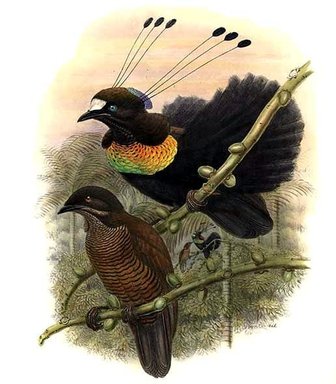Lawes's Parotia
The male is a velvet black bird with an erectile silvery white forehead crest, iridescent purple blue nape and golden green breast plumes. The inside of its mouth is lime-colored. Adorned with three ornamental spatule head wires from behind of each eye and elongated black flank feathers, that spread skirt-like in courtship display. The female is a brown bird with dark head, yellow iris and dark-barred yellowish brown below. The iris is colored in various amounts of blue and yellow, changing according to the bird's mood.

The Lawes's Parotia is classified as Least Concern. Does not qualify for a more at risk category. Widespread and abundant taxa are included in this category.
Lawes's Parotia, Parotia lawesii, is a medium-sized (up to 27 cm long) passerine of the birds of paradise family, Paradisaeidae. It is distributed and endemic to mountain forests of southeast and eastern Papua New Guinea. Occasionally, the Eastern Parotia is considered a subspecies of P. lawesii. The male is a velvet black bird with an erectile silvery white forehead crest, iridescent purple blue nape and golden green breast plumes. The inside of its mouth is lime-colored. More
Lawes's Parotia, Parotia lawesii, is a medium-sized (up to 27 cm long) passerine of the birds of paradise family, Paradisaeidae. Occasionally, the Eastern Parotia is considered a subspecies of P. lawesii. The bird's home was discovered by Carl Hunstein on a mountain near Port Moresby in 1884. Its name honors the New Guinea pioneer missionary Reverend William George Lawes. More
Widespread and common throughout its range, Lawes's Parotia is evaluated as Least Concern on the IUCN Red List of Threatened Species. It is listed on Appendix II of CITES. Read more at Wikipedia This entry is from Wikipedia, the user-contributed encyclopedia. If you find the content in the 'About' section factually incorrect, defamatory or highly offensive you can edit this article at Wikipedia. For more information on our use of Wikipedia please read our FAQ. More
Single captive males of Lawes's Parotia Parotia lawesii were watched calling, displaying, clearing their courts and feeding, one in Rotterdam Zoo and the other at Baiyer River Sanctuary. They displayed on cleared courts, performing highly complex sequential dances of stereotyped movements with specific postures and feather movements. Behavioural data presented are consistent with the view, based on morphological evidence, that the longer-tailed species of Parotia are primitive and shorter-tailed ones derived. More

Family : Paradisaeidae
Genus : Parotia
Species : lawesii
Authority : Ramsay, 1885
